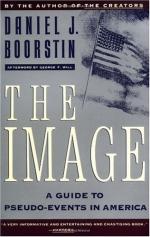
|
| Name: _________________________ | Period: ___________________ |
This test consists of 15 multiple choice questions and 5 short answer questions.
Multiple Choice Questions
1. What title did Mussolini go by after 3 years in office as Prime Minister?
(a) Il Capitain.
(b) Il Deuce.
(c) Il Furor.
(d) Mein Furor.
2. What is the first aspect of a pseudo-event, according to Boorstin?
(a) It is intended as a self-fulfilling prophecy.
(b) It is ambiguous.
(c) Its purpose is to be recreated or reported.
(d) It is intentionally created.
3. What does Boorstin claim increased the ease of creation and transmission of several different types of media?
(a) World Wide Web.
(b) Graphic Revolution.
(c) The printing press.
(d) Media Revolution.
4. When did the development of hotels with leisure complexes become a popular development in the United States?
(a) 1940s.
(b) 1930s.
(c) 1960s.
(d) 1950s.
5. When was Al Capone indicted for income tax evasion and various violations of the Volstead Act?
(a) 1940.
(b) 1919.
(c) 1931.
(d) 1941.
6. When was Benito Mussolini born?
(a) 1905.
(b) 1869.
(c) 1883.
(d) 1911.
7. Boorstin writes that critical history and critical biography have reduced heroes to mere pawns of what?
(a) The media.
(b) Social forces.
(c) Chess.
(d) The public.
8. Karl Baedeker followed the model of English guide books instituted by whom?
(a) Michael Miller.
(b) James Anderson.
(c) Thomas Cook.
(d) John Murray.
9. What refers to a tendency in contemporary culture characterized by the rejection of objective truth and global cultural narrative or meta-narrative?
(a) Pseudo-event.
(b) Nonreality.
(c) Post-modernism.
(d) Hyper-reality.
10. Where was Karl Baedeker born?
(a) Poland.
(b) Essen.
(c) Russia.
(d) Switzerland.
11. What term does Boorstin assert has been relegated to the experiences of young children or naïve adults?
(a) Politicians.
(b) Fairy tales.
(c) Celebrity.
(d) Hero.
12. In what year did Thomas Cook's train tours first go to Scotland?
(a) 1825.
(b) 1901.
(c) 1846.
(d) 1859.
13. When was Charles Lindbergh born?
(a) 1900.
(b) 1911.
(c) 1902.
(d) 1915.
14. When did Karl Baedeker die?
(a) 1905.
(b) 1805.
(c) 1859.
(d) 1847.
15. What was one of Charles Lindbergh's nicknames?
(a) Lucky Chuck.
(b) Lucky Lindy.
(c) Wings.
(d) The Flyer.
Short Answer Questions
1. In his argument in Chapter 2 - Section IV, what does Boorstin suggest are created by the media?
2. Boorstin asserts that the influx of pseudo-events has caused the confusion of participant and what roles?
3. What does Boorstin refer to propaganda as, in Chapter 1- Section IV?
4. What refers to a form of communication that is aimed at influencing the attitude of a community toward some cause or position?
5. What does Boorstin assert has been provided in exotic locations, in Chapter 3 - Section IV?
|
This section contains 370 words (approx. 2 pages at 300 words per page) |

|




